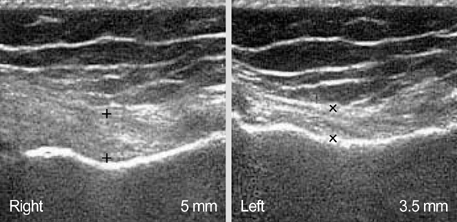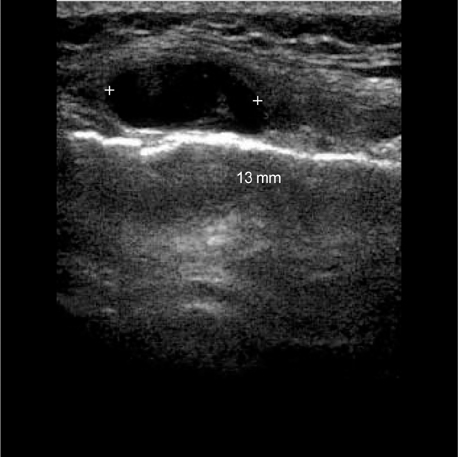J Korean Med Sci.
2005 Feb;20(1):109-112. 10.3346/jkms.2005.20.1.109.
Correlation between Ultrasonographic Findings and The Response to Corticosteroid Injection in Pes Anserinus Tendinobursitis Syndrome in Knee Osteoarthritis Patients
- Affiliations
-
- 1Department of Internal Medicine, Hallym University Kangdong Sacred Heart Hospital, Seoul, Korea.
- 2Department of Radiology, Hallym University Kangdong Sacred Heart Hospital, Seoul, Korea.
- 3Department of Internal Medicine, Hallym University Sacred Heart Hospital, Anyang, Korea. kimha@hallym.ac.kr
- KMID: 1781736
- DOI: http://doi.org/10.3346/jkms.2005.20.1.109
Abstract
- The objectives of this study were to assess the ultrasonographic (US) findings in patients with knee osteoarthritis (OA) with pes anserinus tendinitis or bursitis (PATB) syndrome and to determine the correlation between the US findings and the response to local corticosteroid injection. We prospectively studied 26 patients with knee OA with clinically diagnosed PATB syndrome. A linear array 7 MHz transducer was used for US examination of the knee. Seventeen patients were injected locally with tramcinolone acetonide in the anserine bursa area. Response to local corticosteroid injection was evaluated by pain visual analog scale (VAS), Western Ontario and MacMaster (WOMAC) osteoarthritis index and Global patient/physician assessment using Likert scale. On US examination, only 2 patients (8.7%) showed evidence of PATB. Pain VAS, WOMAC pain index and WOMAC physical function index improved significantly after corticosteroid injection. Global patient assessment revealed that 2 patients showed best response, 6 good, 1 fair, 8 the same, and none worse. It is of note that the 2 patients who showed the best response were those who showed US evidence of PATB. This finding shows that US can serve as a useful diagnostic tool for guiding treatment in PATB syndrome of OA patients.
Keyword
MeSH Terms
-
Adrenal Cortex Hormones/*pharmacology
Aged
Bursitis/ultrasonography
Female
Glucocorticoids/pharmacology
Humans
Knee/*pathology
Male
Middle Aged
Osteoarthritis, Knee/*diagnosis/drug therapy/*ultrasonography
Pain
Pain Measurement
Research Support, Non-U.S. Gov't
Tendinitis/pathology/ultrasonography
Treatment Outcome
Figure
Reference
-
1. Biundo JJ. Schumacher HR, editor. Regional rheumatic pain syndromes. Primer on the rheumatic diseases. 1997. 11th ed. Atlanta (GI): Arthritis Foundation;144.2. Handy JR. Anserine bursitis: A brief review. South Med J. 1997. 90:376–377.
Article3. Kang I, Han SW. Anserine bursitis in patients with osteoarthritis of the knee. South Med J. 2000. 93:207–209.
Article4. Brookler MI, Mongan ES. Anserine bursitis, a treatable cause of knee pain in patients with degenerative arthritis. California Medicine. 1973. 119:8–10.5. Dieppe PA, Buckwalter JA. Klippel JH, Dieppe PA, editors. Management of limb joint osteoarthritis. Rheumatology. 1998. 2nd ed. London, U.K.: Mosby;8.9.1.6. Cohen SE, Mahul O, Meir R, Rubinow A. Anserine bursitis and non-insulin dependent diabetes mellitus. J Rheumatol. 1997. 24:2162–2165.7. Kellgren JH, Lawrence JS. Radiological assessment of osteoarthrosis. Ann Rheum Dis. 1957. 16:494–502.
Article8. Uson J, Aguado P, Bernad M, Mayordomo L, Naredo E, Balsa A, Martin-Mola E. Pes anserinus tendino-bursitis: what are we talking about? Scand J Rheumatol. 2000. 29:184–186.9. Bae SC, Lee HS, Yun HR, Kim TH, Yoo DH, Kim SY. Cross-cultural adaptation and validation of Korean Western Ontario and McMaster Universities (WOMAC) and Lequesne osteoarthritis indices for clinical research. Osteoarthritis Cartilage. 2001. 9:746–750.
Article10. Hall FM, Joffe N. CT imaging of the anserine bursa. Am J Roentgenol. 1988. 150:1107–1108.
Article11. Voorneveld C, Arenson AM, Fam AG. Anserine bursal distension: diagnosis by ultrasonography and computed tomography. Arthritis Rheum. 1989. 32:1335–1338.12. Unlu Z, Ozmen B, Tarhan S, Boyvoda S, Goktan C. Ultrasonographic evaluation of pes anserinus tendino-bursitis in patients with type 2 diabetes mellitus. J Rheumatol. 2003. 30:352–354.13. Larsson L, Baum J. The syndrome of anserine bursitis: an overlooked diagnosis. Arthritis Rheum. 1985. 28:1062–1065.14. Abeles M. Anserine bursitis. Arthritis Rheum. 1986. 29:812–813.15. Do JH, Hur SE, Paek SI, Nah JM, Kim CH, Lee SH, Park SH, Cho CS, Kim HY, Kim WU. Comparison of clinical efficacy between nonsteroidal anti-inflammatory drugs and acetaminophen in knee osteoarthritis according to ultrasonographic findings. J Korean Rheum Assoc. 2004. 11:14–24.
- Full Text Links
- Actions
-
Cited
- CITED
-
- Close
- Share
- Similar articles
-
- Snapping Pes Syndrome after Unicompartmental Knee Arthroplasty
- Snapping Pes Anserinus Caused By Gracilis Tendon: A New Mechanism Proposed by Dynamic Knee Ultrasonography
- Clinical Study of Operative Treatment of Medical Collateral Ligamentous Injuries of the Knee Joint
- Aspiration and Injection of the Knee Joint: Approach Portal
- Can medial stability be preserved after open wedge high tibial osteotomy?



